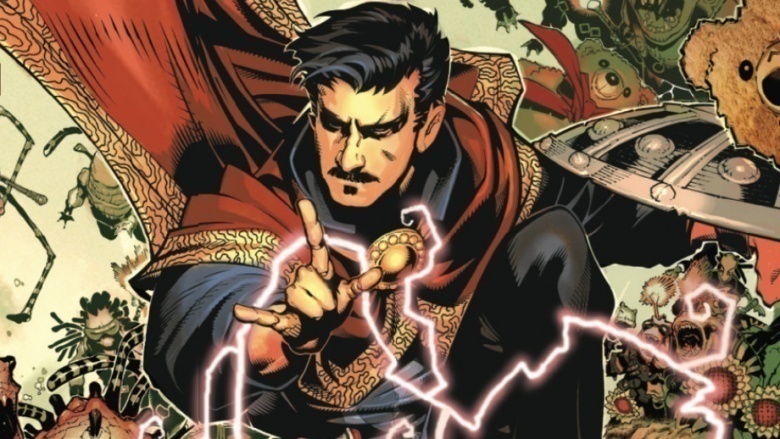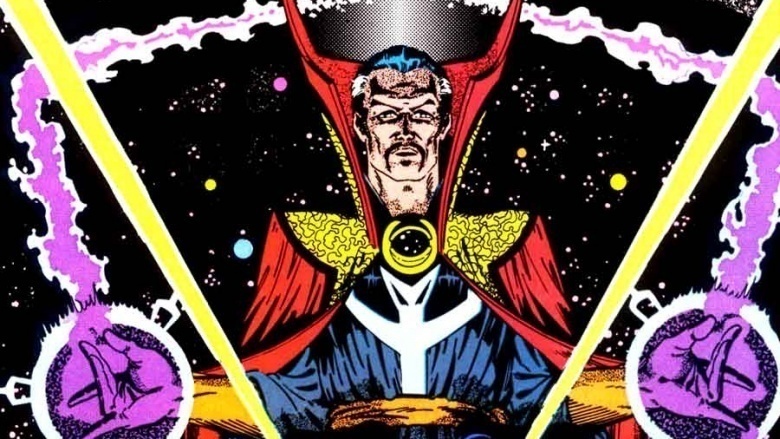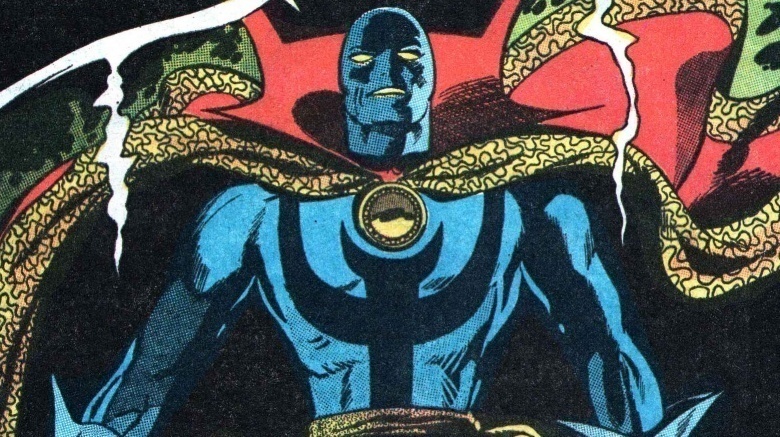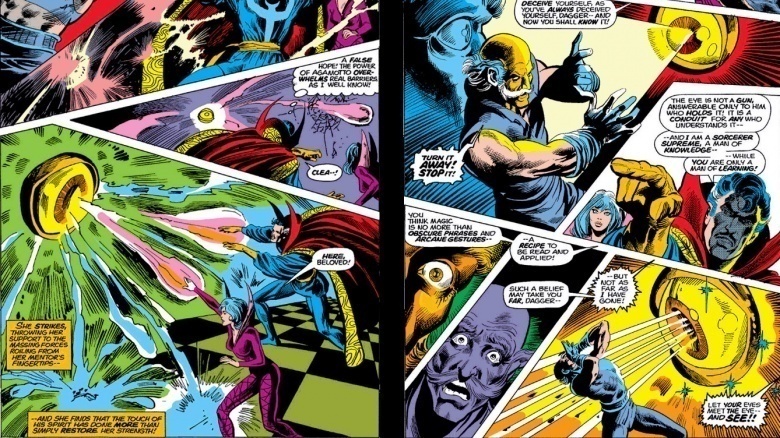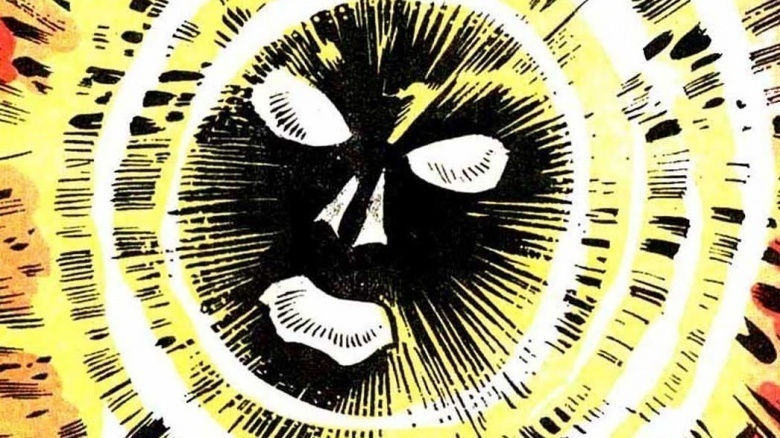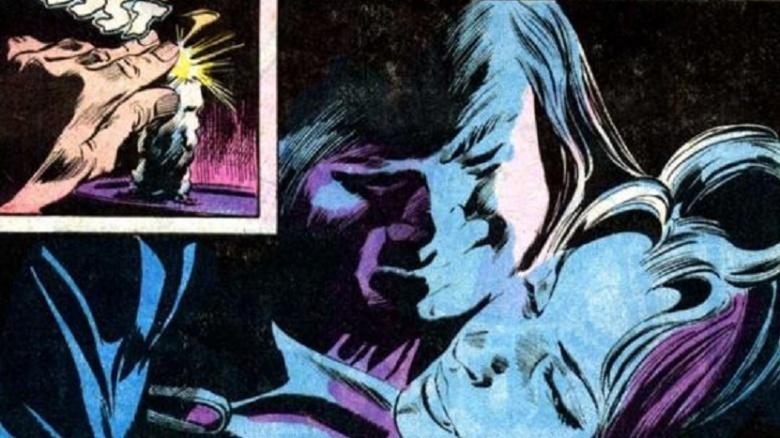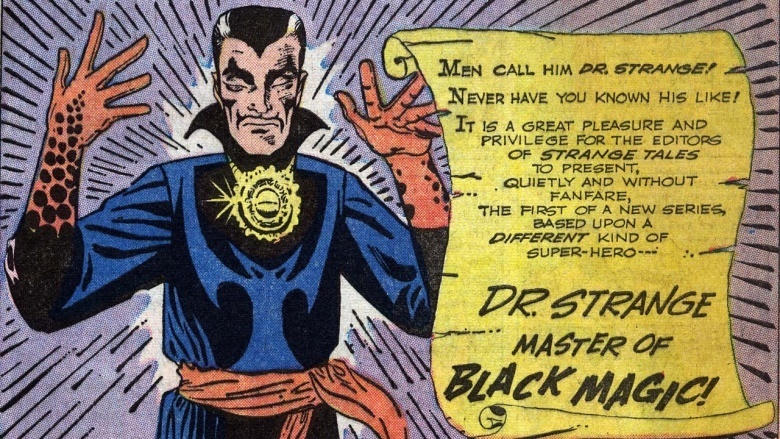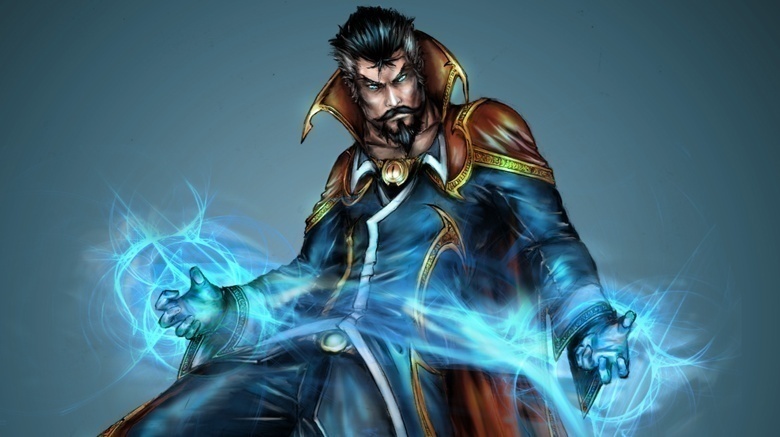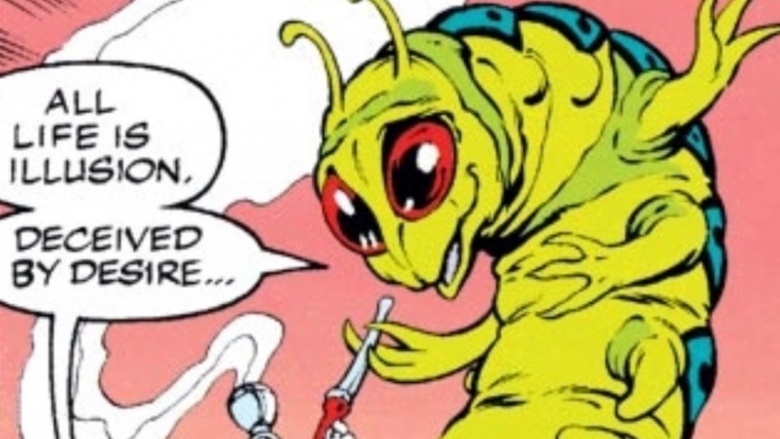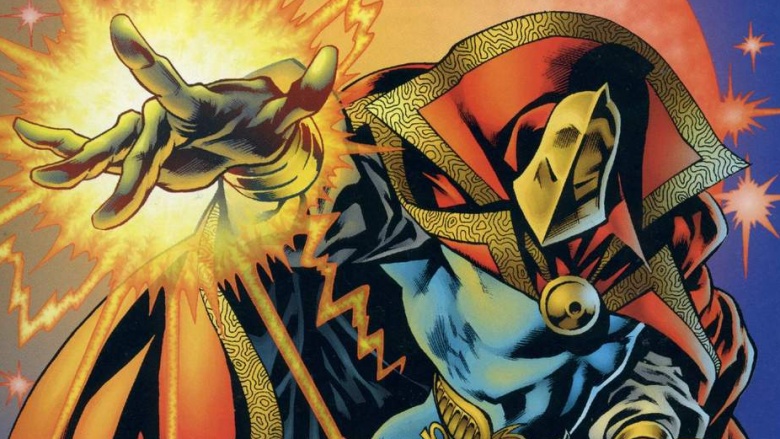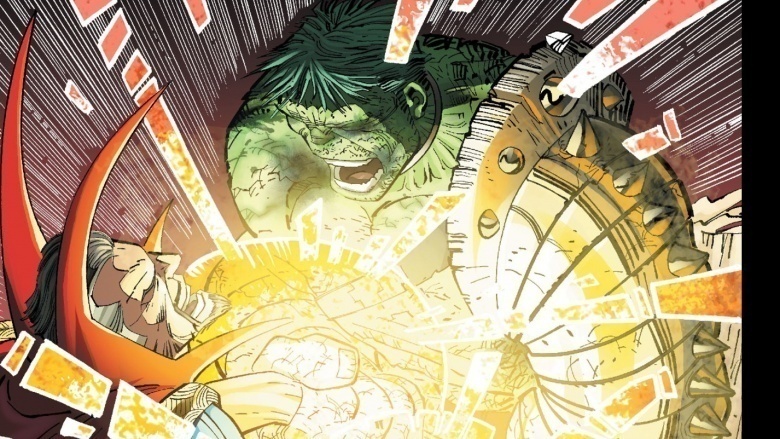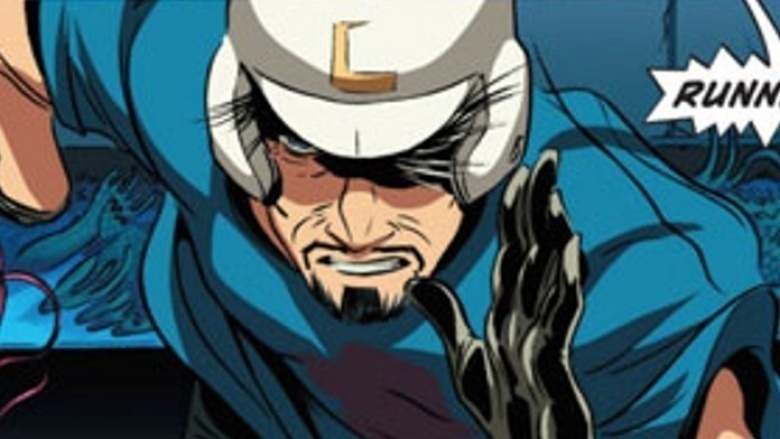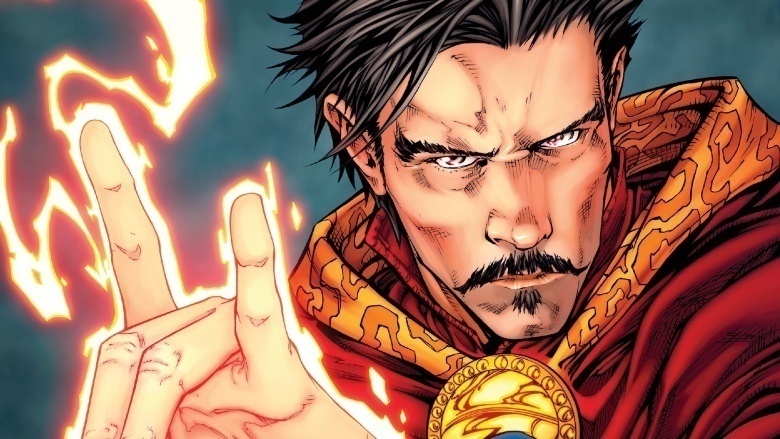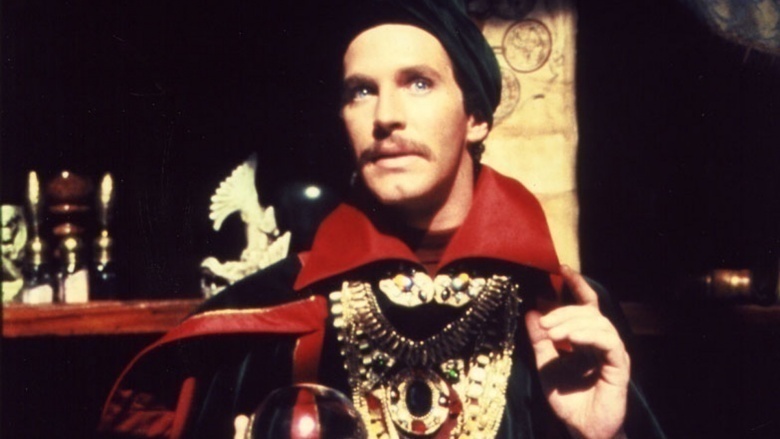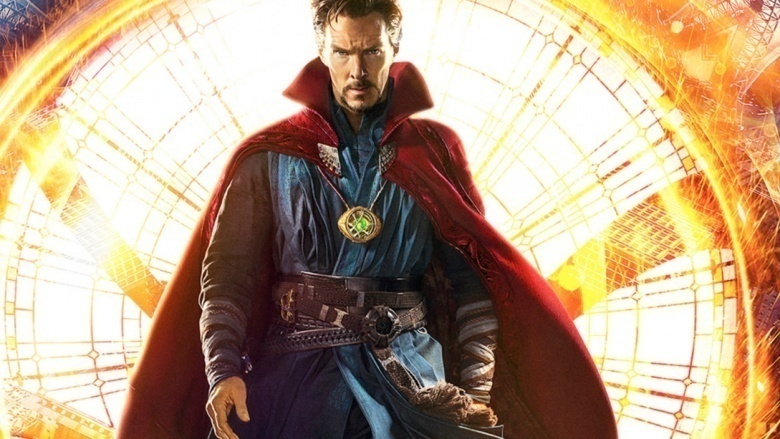The Insane History Of Doctor Strange
Marvel Comics debuted one of the publisher's strangest—pardon the phrase—characters in 1963. As conceived by Stan Lee and Steve Ditko, Dr. Strange was initially intended only as filler for the popular Marvel anthology series Strange Tales. His first story covered only eight pages of the book; clearly, creators Ditko & Lee had no idea the character would go on to become a signature Marvel hero.
Inspired by the pulpy supernatural mysteries of The Shadow and the popular radio program Chandu the Magician, Dr. Strange comics followed the adventures of Stephen Strange, a brilliant former surgeon. A terrible car accident caused major nerve damage to his hands, ending his medical career and sending him in search of alternative medicine that could restore his dexterity. A journey to the Himalayan mountains introduced Strange to the Ancient One, a fabled magician capable of curing any ailment—but who refused to help Strange because of his selfish past. Soon after, Strange intervened when a former disciple tried to kill the Ancient One, demonstrating his worth and earning a place as his apprentice. Upon returning to New York, Strange continued to defend the world from evil—battling threats native to Earth as well as from other dimensions.
The stoner days
Dr. Strange's earliest comics attracted their share of raised eyebrows. The title made for a bizarre mix with established characters like Spider-Man or Captain America, and at first remained confined to its own small section of the Marvel Universe. Ditko and Lee populated Strange's adventures with lots of crazy and vivid images and imbued the stories with a weird mix of mythology, cosmology, psychology, and religion, crafting a surreal and metaphysical tone that made the character an immediate hit with older readers, especially college students who searched for a deeper meaning. Lee and Ditko, for their part, never intended any subliminal messages.
Be that as it may, the character attracted immediate allegations of drug themes. It was the 1960s, after all, and spiritual tone and surrealistic images of Dr. Strange comics played to the fascination with drugs at the time. As the decade wore on, psychedelic drug use became more popular and so did Dr. Strange, prompting Marvel to issue a statement denying allegations of drug use by company staff. Dr. Strange also rose in popularity thanks to a renewed youthful interest in Eastern philosophy, religion and mysticism. The character became an unlikely superhero, albeit one that fought cosmic beings rather than bank robbers.
Identity theft
As the decade drew to a close, letter columns started filling up with debates over whether Dr. Strange comics should continue in their traditional vein (i.e. Strange finding himself in a trippy alternate dimension and having to battle an unwelcoming lord) or look to bring Strange in line with Marvel's more traditional heroes. The latter argument won out, and in 1969's The Cult and the Curse, the Doc was given a makeover.
This arc sees Strange trapped in another dimension (Marvel didn't want to go too off-brand right away) by Asmodeus, who takes the form of Stephen Strange and steals his identity, heading to Earth and posing as the Doctor in hopes of using the Ancient One's Book of Vishanti to release hell. Strange, of course, makes it back in time to defeat Asmodeus, though not before doing away with his traditional garb in favor of a suit that was more in line with what other Marvel heroes were sporting at the time. Strange's all-over blue garb saw him fighting in a mask for the first time, with his uninspired appearance drawing comparisons to the Silver Surfer. By the '70s, this wardrobe change had been rectified and all but forgotten.
Through the Looking Glass
In his early days, Dr. Strange remained confined to Strange Tales, an anthology title featuring a rotating roster of characters. He remained one of the most popular, however, and earned multi-issue story arcs devoted to his adventures. What readers did not anticipate was just how insanely, well, strange Dr. Strange's adventures could get. One notorious case in point: in 1974, at the height of Dr. Strange's psychedelic phase, one story had the good doctor journeying to Lewis Carroll's Wonderland. In "The Silver Dagger," Dr. Strange entered his magical crystal, the Orb of Agamotto, and found a world populated by the characters from Alice's Adventures in Wonderland and Through the Looking Glass, including a hookah-smoking caterpillar and a gigantic white rabbit. The Doctor also encountered a number of other Marvel characters and took part in a superheroic tea party.
From time to time, Dr. Strange behaved out of character. One notable example: "Triumph and Torment," which found him teaming up with Marvel villain Dr. Doom. The two magicians used their combined powers to enter the realm of Mephisto (the Marvel version of Hell) to rescue Doom's mother. Featuring art by Mike Mignola (creator of Hellboy), "Triumph and Torment" became a fan favorite, as it added character layers to both Dr. Strange and Dr. Doom, as well as an eerie camaraderie between the two.
Fake fan mail
Artist Frank Brunner and writer Steve Englehart were largely left to their own devices when it came to their work on Dr. Strange, though in 1974 one of their Sise-neg/Genesis story arcs caught the attention of Stan Lee. When the Marvel supremo picked up a copy of Marvel Premiere #14, he took issue with a section of the story that essentially revolved around Strange following God as he creates the universe. Lee contacted the pair to remind them both that Marvel "don't do God" and asked them to write a retraction claiming that the God in their story wasn't the God, just one of many.
Brunner and Englehart knew their story wouldn't work as well if they had to retroactively alter it, and the duo came up with a cunning plan to make sure that didn't happen. Together they wrote a fake fan letter from a made-up Texas reverend claiming to have been shown the comic by one of the kids in his church and absolutely loving it. Englehart posted the letter from a Texas postbox to avoid suspicion (they needed a Texas postage stamp for authenticity's sake) and Marvel fell for it, printing the writers' bogus letter in place of their retraction.
The Benjamin Franklin affair
Englehart's run with the character ended in suitably (ahem) strange fashion—he was taken off the title and replaced by his editor Marv Wolfman after the memorable (for all the wrong reasons) 18th issue. Dr. Strange numbers 1 through 17 had been based around Strange and his love Clea travelling through America's past to learn about the country's history of occultism, and this journey of mystic discovery led to them crossing paths with none other than Benjamin Franklin.
Nothing wrong with that, you might be thinking. No harm in combining comics with a little education now and again, you could say. What nobody was expecting, however, was for Clea to have a steamy affair with the portly founding father. Well, as steamy as the Comics Code of the day would allow, but one thing was made abundantly clear—Clea slept with Franklin behind Strange's back. While it was near impossible to get this image out of your mind after seeing it, one of Wolfman's first tasks after taking the reins was to make like it never happened, revealing that Franklin was actually just Stygyro in disguise and not the real renowned scientist and diplomat.
Black Magic
The 1980s were something of a purple patch for Dr. Strange, with the character appearing in a vast number of different titles throughout the decade outside of his own bimonthly, including an unlikely team-up with Dr. Doom. Strange was leader of the Defenders at the time, regularly summoning heroes like the Hulk, Valkyrie and Nighthawk to help fight his battles, though as the '80s drew to a close there was a sudden change in direction. In the final story arc of his own title (playing out over issues 75 to 81), Strange is forced to destroy all of his mystic scrolls and talismans in order to save the world from evil alien sorcerer Urthona, killing his human host in the process. When the doc returned in '87 for Strange Tales Vol. 2, he was more conflicted than the character we were used to.
The Sorcerer Supreme lost an eye in issue #10 and started rocking an eyepatch, a look that worked well for a darker incarnation of the character who regularly dabbled in black magic with varying results. The '80s Dr. Strange was responsible for one of the most memorable Incredible Hulk story arcs of the time when he sent the big green guy to the interdimensional crossroads, though he also ended up fusing himself with a demon warlock from another dimension to create a hybrid being with wavy blond glam-rock hair. Hey, they can't all be classics.
Siege of Darkness
The '90s saw a rise in popularity for supernatural and occult-based superheroes like Spawn and Buffy the Vampire Slayer. To cater to this new audience, Marvel launched a new team of heroes called the Midnight Sons, with Strange as a member.
Strange made his first appearance as one of the Midnight Sons during their "Siege of Darkness" storyline. In it, he joined forces with the Ghost Rider, the vampire Morbius, and the subterranean dweller Caretaker to take on an evil demon named Lilith. Strange also rejoined the Defenders, helping to mentor the group, and expanded the reach of his powers. But as the '90s waned, so did Strange's popularity. By the mid-2000s, he'd retreated to secondary character status, though he continued to play a vital role in the Marvel universe.
Dr. Strange had also acquired an unlikely enemy: singer Amy Grant. A 1990 cover for an issue of Dr. Strange used Grant's likeness without permission. The singer sued, fearing that the association with witchcraft would hurt her image as a Christian music singer. Marvel settled the suit out of court.
An eye for an eye
The 1990s saw the return of a more athletic Dr. Strange, one who was quick to abandon the dark arts and turn back to using white magic, though his change of heart didn't stop him from teaming up with planet-consuming cosmic entity Galactus in 1992's Dr. Strange #43. The story, titled "An Eye for an Eye," follows the unlikely pair as they attempt to find out what has happened to Eternity, the abstract leader of the Cosmic Powers of the Marvel Universe who granted Strange permission to use the Eye of Agamotto in his battle against Dormammu. Still with us? Good, because it is about to get even stranger.
Galactus demands that he be allowed to use the Eye to help hunt for Eternity, and Strange agrees to loan it to him. Agamotto doesn't like this, however, and proceeds to transport Strange to his dimension for a good talking to. This is where the character's (and the writers') obsession with Alice In Wonderland comes back to the fore, with Agamotto appearing as a giant hookah-smoking caterpillar. Strange calls on Galactus for assistance, and the pair take on Agamotto in a battle that ends with the Eye being fused to the doc's forehead.
Crossing the divide
The '90s wasn't just a bizarre time to be a Dr. Strange reader—it was an odd time for comics fans in general. The most exciting yet head-scratching part of the decade was the formation of the Amalgam Universe, in which Marvel and DC came together to do battle and then join forces. Literally.
When the physical incarnations of the Marvel and DC universes (referred to only as the Brothers in the crossover comics) suddenly become aware of each other after eons of ignorance, each prepares the heroes of their universe to do battle against those from the other. After the fighting is done, however, neither side will admit defeat, causing the brothers (and all of the heroes) to merge.
Aquaman merged with Namor and Superman merged with Captain America, though the most powerful being in the whole Amalgam universe was Dr. Strangefate, a combination of Marvel's Dr. Strange and Professor X merged with DC's Dr. Fate. The character's all-powerful standing meant that he would do anything to keep the new universe from being separated again, though Access (a gatekeeper character co-created by Marvel and DC) eventually showed the brothers the error of their ways and convinced them to return to the status quo.
World War Hulk
In addition to his solo adventures and his duties to the Defenders and the Midnight Sons, Dr. Strange also formed the llluminati of the Marvel universe (yes, that's their real name). Though stories imply the group formed decades ago, the Illuminati emerged as a force after the events of Marvel's 2006-'07 Civil War crossover event. Strange joined Mr. Fantastic (of the Fantastic Four), Professor X (of the X-Men), Iron Man, Black Bolt (of the Inhumans), and Prince Namor to form the group with the intention of better preventing dangerous attacks from alien races or superpowered humans. When the Hulk ravaged Las Vegas, the Illuminati, including Dr. Strange, voted to exile him from Earth. The members banded together and managed to trap Hulk inside a rocket before firing him off to a distant world.
The Hulk would not remain in exile forever, though. Several years later, he returned to Earth, angrier and more powerful than ever. The resulting storyline, dubbed World War Hulk, followed the green giant as he exacted revenge on every member of the Illuminati, including Dr. Strange. Strange invoked dark magic to stop the Hulk, though his powers caused massive damage and harmed innocent bystanders. As Strange tried to control his powers, the Hulk managed to force him, along with the rest of the Illuminati, to duel one another to the death before a character known as the Sentry intervened and defeated the Hulk, leaving the Illuminati's members to ponder their actions.
Demonic baseball
Dr. Strange has continued his legacy as a cult character into the present day, and his adventures haven't gotten any less crazy over the years. In 2010, he lost most of his powers; naturally, since Strange had spent decades battling dark sorcerers and demons, his enemies moved to seek vengeance right away. Their method, however, proved bizarre, even in the context of Dr. Strange.
After losing his powers, Strange decided to take in a baseball game to clear his mind. While there, he discovered that demons had staged the game to win the souls of the human players. A demonic baseball game in the netherworld commenced, with Strange batting for the human team. The good doctor managed to bat a run for the good guys and the demons lost, setting the human players free and sending Strange home to contemplate what other fiendish plans his enemies had laid out for him.
The magic continues (or does it?)
Doctor Strange has continued to play a pivotal role in Marvel's recent crossover events. During the 2015-'16 Secret Wars arc, Strange banded together once more with Doctor Doom in an effort to stave off the complete annihilation of the Marvel Universe—and ended up serving as Doom's second in command on Battleworld, a cobbled-together planet upon which Doom ruled as a god and the surviving heroes no longer remembered their past. Doom was eventually vanquished, but not before murdering Strange; fortunately for longtime fans, both characters were eventually restored to something like the status quo. (It got pretty complicated.)
More recently, Strange has starred in the latest volume of his solo series, leading a ragged band of sorcerers in a desperate attempt to stop a vicious group known as the Empirikul from wiping out all the magic in the universe. They succeeded—just barely—and as 2016 came to a close, Strange found himself rediscovering his powers and rebuilding his mystical library as magic was slowly restored to Marvel.
Strange Superstar
Dr. Strange hasn't confined his adventures to comic books. He made his first animated appearance in Spider-Man and his Amazing Friends alongside the titular web slinger and several other popular Marvel heroes, and turned up again years later in the 1990s Spider-Man animated series. After his nemesis Dormammu kidnapped Spider-Man's love interest, Mary Jane Parker, Strange helped rescue her. Years later, after Disney purchased Marvel, Strange became a regular figure in animated Marvel shows, joining characters like the Hulk, Spider-Man and the Avengers to fight the forces of evil.
Dr. Strange also enjoyed a brief live-action incarnation. The 1978 television movie Dr. Strange brought the character to the small screen, starring actor Peter Hooton in the title role. Recounting the origins of Dr. Strange, his training with the Ancient One, and his first forays into superheroics, Dr. Strange aired during the same period the Incredible Hulk TV show attracted hit ratings, and CBS intended the film as a pilot for a potential series. Unfortunately, audiences failed to tune in, and the Strange series never materialized.
Strange Hollywood
Things didn't work out as planned in 1978, but that wasn't the last live-action incarnation of Dr. Strange. Plotting out the Marvel Cinematic Universe starting with 2008's Iron Man, the studio set about carefully setting the stage for the arrival of a number of Marvel characters on film through a series of phases. Phase One culminated with the assembly of the Avengers in 2012; over the years, an expanding roster of heroes (including Scarlet Witch, the Vision, Ant-Man, and Spider-Man) have joined Iron Man, Black Widow, Hawkeye, the Hulk, Thor, and Captain America. Early in the MCU's third Phase, Doctor Strange finally marked the Sorcerer Supreme's big-screen arrival in 2016.
The film spent more than a decade in development hell, with a number of high-profile directors and writers attached. Acclaimed director Alex Cox and horror legend Wes Craven both showed interest in the project, though it persistently failed to gather momentum. Finally, in 2014, director Scott Derickson signed on, casting Oscar nominee Benedict Cumberbatch in the title role alongside fellow nominee Chiwetel Ejafor as Baron Mordo and Academy Award winner Tilda Swinton as the Ancient One.
Swinton's acting chops are without peer, but her selection for the role raised more than a few eyebrows; where the Ancient One of the comics is depicted as an Asian man, she is...decidedly neither of those things. To some, Swinton's casting smacked of the longtime Hollywood practice known as "whitewashing"; to others, it was an understandable (albeit clumsy) attempt to circumvent the character's uncomfortable history as a racist stereotype. Either way, it wasn't the kind of pre-release buzz Marvel was hoping to build with Doctor Strange—but by the hoary hosts of Hoggoth, we're betting audiences everywhere will still fall under his spell.
